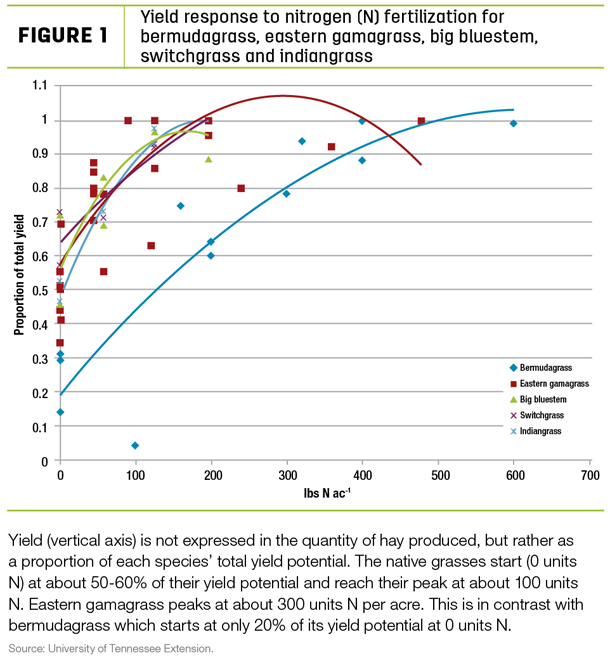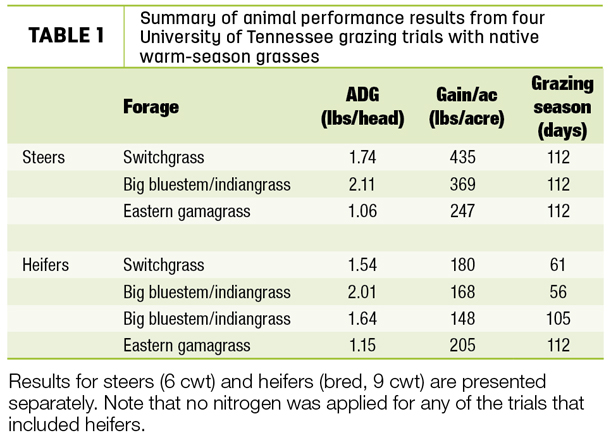Research on these grasses has accumulated in recent years, providing information that can help cattlemen make informed decisions about these forages and how they can fit into their operations.
In this issue, I’ll address several other important topics concerning native grass forages – input requirements, animal performance, grazing management, winter forage production and use of prescribed fire.
Input requirements
Native grasses are able to produce about 60 percent of their maximum potential yield with no nitrogen applications. By comparison, a widely used summer perennial, bermudagrass, may produce only about 20 to 30 percent of its potential yield when nitrogen amendments are not applied (Figure 1).

Potash is also important for bermudagrass production. Conversely, natives have not shown consistent yield responses to either phosphorus or potassium.
Finally, scientists at the University of Tennessee did not observe a yield response in switchgrass with pH above 5.0. While good soil stewardship dictates we should not “mine” nutrients (especially important in hay production), it is clear that native grasses can be productive with limited inputs. Optimum nitrogen recommendations are about 60 units per acre.
Why are natives so thrifty when it comes to fertilizer and lime inputs? The short answer is: We do not know. There is some speculation, though, that mineralization of the large amounts of below-ground biomass these species produce may be part of the explanation. Some studies have documented relationships with nitrogen-fixing soil microbes.
Another possible explanation is: There may be mycorrhizal relationships with the native grasses that provide them with a competitive advantage.
Animal performance
I often hear people describe natives as “low-quality” forages. In the case of over-mature, stemmy plants or species such as broomsedge, that is not an unreasonable statement.
On the other hand, when it comes to big and little bluestem, indiangrass or even switchgrass, cattle perform very well (Table 1).

Our results with steers on eastern gamagrass were more modest and typical of the rates of gain reported for bermudagrass. For summer-long (typically 112-day trials) grazing, which has captured a wide range of temperature and rainfall conditions through the years, these are very solid gains.
Indeed, these gains compare very favorably to those produced by bermudagrass (1.1 pounds per day), many summer annuals (1.6 pounds per day) or remaining on cool-season forages (0.8 pounds per day) during summer.
By any definition, these are not the kind of gains you would expect from “low-quality” forages. For fescue-belt cattlemen, an added advantage of grazing native grasses is relief from the effects of fescue toxicosis during summer when the impact is greatest.
Grazing management
Relative to endophyte-infected tall fescue and bermudagrass, both of which can tolerate a certain amount of close grazing, native grasses require better management. The key issue is that as tall-growing species, natives cannot tolerate persistent, close defoliation. Short-term overgrazing reduces production and increases weed pressure (something true for any forage crop) but rarely will create long-term problems for a native grass pasture.
As a result, graziers must be prepared to monitor and adjust stocking on native pastures more often than what they may have been used to with some of our other common forage grasses.
Despite the need to monitor pasture condition more often, natives can really be pretty simple to graze. In our trials, we have used a simple, three-paddock rotation quite effectively. (Moving cattle every three to 10 days is pretty typical.) In this system, we normally enter a paddock at about 24-inch canopy height and pull off at about 12 inches.
If you prefer not to use a rotational system, continuous grazing for eastern gamagrass and a big bluestem/indiangrass blend has worked well in our trials.
With a set stocking rate – we have used about 900 and 1,800 pounds per acre, respectively, for these two forage options – we have been able to graze for 100 to 120 days (May to August) most years (see photo). Lowland switchgrass, because of a strong growth surge in late spring or early summer, may not lend itself to this type of continuous grazing.
When overgrazing does occur, providing a rest period of a few weeks is all that is normally needed to correct the situation. Stands that have been severely impacted require longer periods of rest to recover.
For example, an eastern gamagrass stand that had been markedly weakened over a three-year period recovered fully following a season-long rest. The bottom line is: If you are willing to pay more attention to your pastures, native grasses are not difficult to manage.
Winter forage production
Although native grasses offer desirable summer forage they, like other warm-season perennials, do not produce during winter. Producers who need grazing during fall or early spring have two options.
First, they can graze the dormant grasses. This is often done in range country but will require a protein supplement. In an ongoing study at the University of Tennessee, heifers have been grazing dormant native grasses for 100 days (January to April) each winter plus a 0.4-pound-per-head-per-day protein supplement. Preliminary results reveal pregnancy rates comparable to those on stockpiled tall fescue.
A second option is to overseed winter annuals (brassicas or small grains) into the stand. Data on this approach are limited. However, preliminary trials suggest that establishing the annuals into native grass stands is not the concern. Rather, the timing of the removal of the winter annual is critical.
Grazing the winter annuals down by early April leaves little competition for the emerging warm-season perennials. On the other hand, winter annuals that are still vigorous in late April create substantial competition, leading to reduced yield and stand vigor in the warm-season species. This is the same challenge faced by bermudagrass growers in the Southeast when they overseed with winter annuals.
Prescribed fire
Native grasses respond very well to burning. Growth begins earlier (by about two weeks) following spring fires. Burning increases photosynthesis rates, shoot mass, tiller density and leaf nitrogen content (which means crude protein goes up).
Cattle preferentially graze more recently burned pastures, and many weeds are suppressed following burning.
On the other hand, burning is not necessary for managing native grass pastures. Many pastures remain productive in the absence of fire for many years, even decades. Thus, if you are considering using native grasses in your forage program, you do not have to also plan to use prescribed fire to manage those pastures.
Recent research demonstrates that use of native grasses in forage programs of the eastern U.S. can provide highly drought-tolerant, high-quality forages with limited inputs.
On the other hand, establishment includes lost production during the summer they are seeded, and management requires closer monitoring of canopy conditions. Whether or not they are an advantage for your operation is a decision you must make. I hope some straight talk, based on university research, can help ensure that decision is the best one for you. ![]()
You can find additional information regarding native grass forages at UT Extension. See series ‘SP731’on native grass forages.
PHOTO: This pasture with big bluestem, indiangrass and little bluestem has been grazed continuously all summer (May to August) under a set stocking rate and is still providing good late summer forage (photo taken July 26). Photo courtesy of Patrick Keyser.

-
Patrick Keyser
- Professor and Director of Center for Native Grasslands Management
- University of Tennessee Institute of Agriculture
- Email Patrick Keyser







